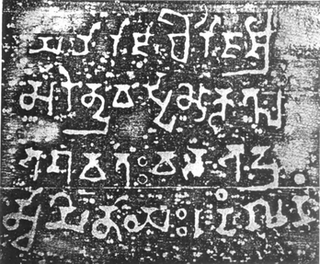
Indian architecture is rooted in the history, culture, and religion of India. Among several architectural styles and traditions, the best-known include the many varieties of Hindu temple architecture and Indo-Islamic architecture, especially Rajput architecture, Mughal architecture, South Indian architecture, and Indo-Saracenic architecture. Early Indian architecture was made from wood, which did not survive due to rotting and instability in the structures. Instead, the earliest existing architecture are made with Indian rock-cut architecture, including many Buddhist, Hindu, and Jain temples.
Tezpur is a town in Sonitpur district, Assam state, India. Tezpur is located on the banks of the river Brahmaputra, 175 kilometres (109 mi) northeast of Guwahati, and is the largest of the north bank cities with a population of 140,000 as per Metropolitan Census 2023.

Guwahati is the biggest city of the Indian state of Assam and also the largest metropolis in northeastern India. Dispur, the capital of Assam, is in the circuit city region located within Guwahati and is the seat of the Government of Assam. A major riverine port city along with hills, and one of the fastest growing cities in India, Guwahati is situated on the south bank of the Brahmaputra. The city is known as the "gateway to North East India".

The Kamakhya Temple at Nilachal hills in Guwahati, Assam is one of the oldest and most revered centres of Tantric practices, dedicated to the goddess Kamakhya. The temple is the center of the Kulachara Tantra Marga and the site of the Ambubachi Mela, an annual festival that celebrates the menstruation of the goddess. Structurally, the temple is dated to the 8th-9th century with many subsequent rebuildings—and the final hybrid architecture defines a local style called Nilachal. It is also one among the oldest 4 of the 51 pithas in the Shakta tradition. An obscure place of worship for much of history it became an important pilgrimage destination, especially for those from Bengal, in the 19th century during colonial rule.

Kamakhya, a mother goddess, is a Shakta Tantric deity; considered to be the embodiment of Kama (desire), she is regarded as the goddess of desire. Her abode–Kamakhya Temple is located in the Kamarupa region of Assam, India. Originally a Kirata goddess, Kamakhya remained outside Brahmanical influence until at least 7th century CE. Residing on Nilachal hills across the banks of the Brahmaputra river, west of Guwahati in the 10th/11th century Temple rebuilt in 1565 CE, she is worshiped in a non-iconic and un-anthropomorphic form of stone shaped like yoni fed by a perennial stream. The temple is primary amongst the 51 Shakti Pithas, and is one of the most important Shakta temples.

The history of Assam is the history of a confluence of people from the east, west, south and the north; the confluence of the Austroasiatic, Tibeto-Burman (Sino-Tibetan), Tai and Indo-Aryan cultures. Although invaded over the centuries, it was never a vassal or a colony to an external power until the third Burmese invasion in 1821, and, subsequently, the British ingress into Assam in 1824 during the First Anglo-Burmese War.

The Mlechchha dynasty ruled Kamarupa from their capital at Harruppesvar in present-day Tezpur, Assam, after the fall of the Varman dynasty. According to historical records, there were twenty one rulers in this dynasty, but the line is obscure and names of some intervening rulers are not known. Like all other Kamarupa dynasties a semi-mythical lineage from Narakasura was constructed to accord legitimacy to their rule. The Mlechchha dynasty in Kamarupa was followed by the Pala kings. The dynasty is unrelated to the previous Varman dynasty.

Susenghphaa or Pratap Singha, was the 17th and one of the most prominent kings of the Ahom kingdom. As he was advanced in years when he became king, he is also called the burha Raja. His reign saw an expansion of the Ahom kingdom to the west, the beginning of the Ahom-Mughal conflicts, and a reorganization of the kingdom with an expanded Paik system and reoriented village economy designed by Momai Tamuli Borbarua. His expansion to the west is underlined by the two new offices that he created: that of the Borbarua and the Borphukan. The alliances he formed with the rulers of Koch Hajo resulted in formation that successfully thwarted Mughal expansion. The administrative structure that he created survived until the end of the Ahom kingdom in 1826.

The Ahom kingdom was a late medieval kingdom in the Brahmaputra Valley. It maintained its sovereignty for nearly 600 years having successfully resisted Mughal expansion in Northeast India. Established by Sukaphaa, a Tai prince from Mong Mao, it began as a mong in the upper reaches of the Brahmaputra based on wet rice agriculture. It expanded suddenly under Suhungmung in the 16th century and became multi-ethnic in character, casting a profound effect on the political and social life of the entire Brahmaputra valley. The kingdom became weaker with the rise of the Moamoria rebellion, and subsequently fell to repeated Burmese invasions of Assam. With the defeat of the Burmese after the First Anglo-Burmese War and the Treaty of Yandabo in 1826, control of the kingdom passed into East India Company hands.
Itakhuli or Sukreswar Hill is a small hill on the south bank of the Brahmaputra at Guwahati. The past official residence of the Deputy Commissioner of Kamrup District of Assam was located on top of this hill. The D.C. bungalow was vacated for the Brahmaputra river side development. Adjacent to it in the western side of the D.C.'s bungalow is the Sukreswar Temple. Itakhuli hill have always have been of strategic importance it was the seat of the viceroys and a garrison since the early days of Kamrup from Ahom, to Mughal and to the British. If one stands on the lawns on the back side of the D.C. Bungalow one can have a panoramic view of Brahmaputra River with the Karmanakha rocks and Uma Nanda Temple on the Peacock island in the middle, with hills of Nilachal or Kamakhya on the west and Agiathuri hills far off in the north west, Manikarneswar hill and Aswaklanta on the north bank of the river, the Kurua hills on the northeast.

The Rudreswar Temple or Devaloya is a temple dedicated to Lord Shiva in the village of Rudreswar, under Sila Sindhurighopa Mouza, on northern bank of the river Brahmaputra, in Guwahati. Built in 1749 CE by Ahom king Pramatta Singha, in memory of his father Swargadeo Rudra Singha, the temple is a fine example of a mixed style of Ahom-Mughal architecture.

Kalaigaon is a town and Legislative Assembly Constituency in north-eastern India. It is situated in the Udalguri district of Assam state. The average altitude is 37 meters. The climate is humid and congenial, while the relative humidity is around 82%. The annual rainfall is around 2,000 mm.

The Kamarupa Anusandhana Samiti is the oldest Research institution in North-East India, which was established in the year 1912 at Kamakhya with a view to working in the field of antiquarian study and research, particularly on the subject of History, Archaeology, Anthropology, Culture etc. It was this society that started the Museum movement for the collection and preservation of antiquities culminating in the birth of the Assam State Museum in 1940.
Kamakhya is a locality in Guwahati, Assam, which is 20 kilometres (12 mi) from the Guwahati Airport and about 6 km from Guwahati Railway Station, it also has own railway junction called Kamakhya Junction.

Kamrup is the modern region situated between two rivers, the Manas and the Barnadi in Western Assam, with the same territorial extent as the Colonial and post-Colonial "Undivided Kamrup district". It was the capital region of two of the three dynasties of Kamarupa and Guwahati, the current political center of Assam, is situated here. It is characterized by its cultural artifacts.

The Umachal rock inscription is one of the earliest epigraphic sources discovered in Assam. Dated to the 5th century, the rock description was discovered in the north-eastern slopes of the Nilachal Hills, near Guwahati city. The artifact is dated primarily on the basis of the identification of the named Surendravarman with Mahendravarman of the Varman dynasty. The script is in the Nagari variety of the Gupta script and the language is Sanskrit prose. Though the Nilachal Hills is known for the Kamakhya Temple, a shakta/tantra site, this temple was for Balabhadra, a god of the Vaishnavite pantheon.
Amati, also known as Ambuvachi, is a ritual followed in Kamrup and Goalpara regions in Western Assam. It is an ancient fertility cult and also incorporated into the mother goddess cult as Kamakhya as its centre.

Assamese Brahmins are the Brahmins present in the Assamese society. There they promoted learning, Vedic religion, astrology, ayurveda and as well as imparting general vedic knowledge to the public. The Brahmins came to Assam from Videha (Mithila), Kannauj, Bengal and many other places.
Haribhanga is an agricultural village of Nalbari district in Western Assam under 45 No. Paschim Nambarbhag Gram Panchayat. Eighty percent of the population of this village depends on agriculture for their livelihood. For the development of economic, social, political, art and culture of the greater Haribhanga area, the Haribhanga Gaon Unnayan Sammittee was formed in. 1945. The most renowned, historical and religious holy place of Haribhanga is the Kaliya Gosai Mandir.
Himanta Biswa Sarma was sworn in as Chief Minister of Assam on 10 May 2021, which led to the formation of his ministry and the current Government of Assam. He succeeded his colleague Sarbananda Sonowal. He was administered the oath by Governor Jagdish Mukhi. Himanta Biswa Sarma became the 15th Chief Minister of Assam. BJP national president JP Nadda and other leaders were also present at the ceremony.















